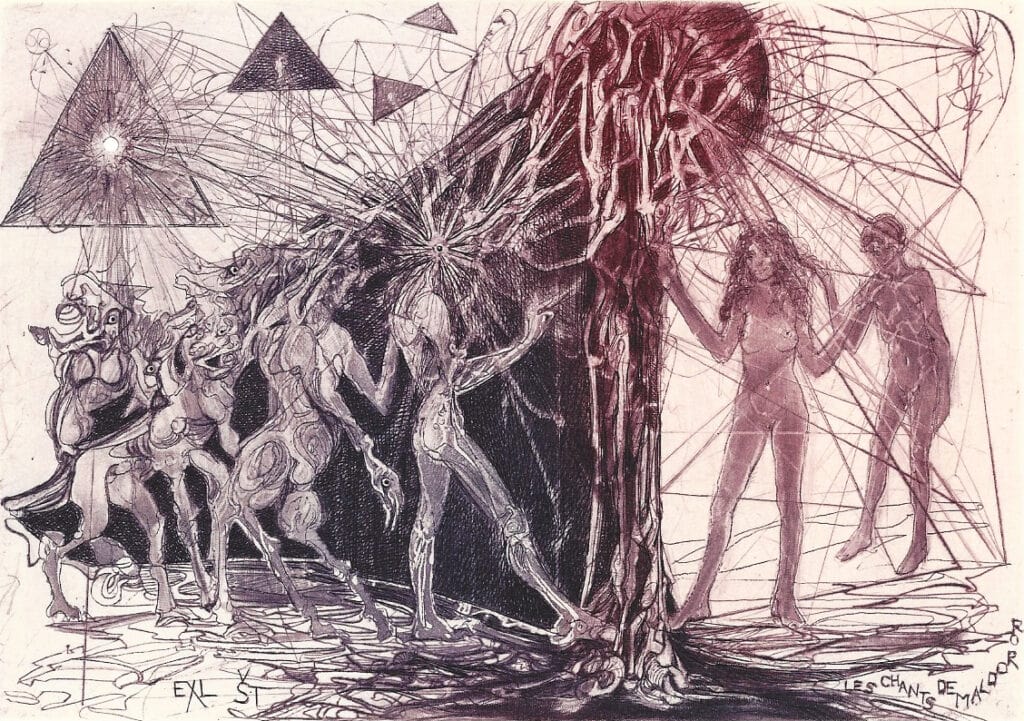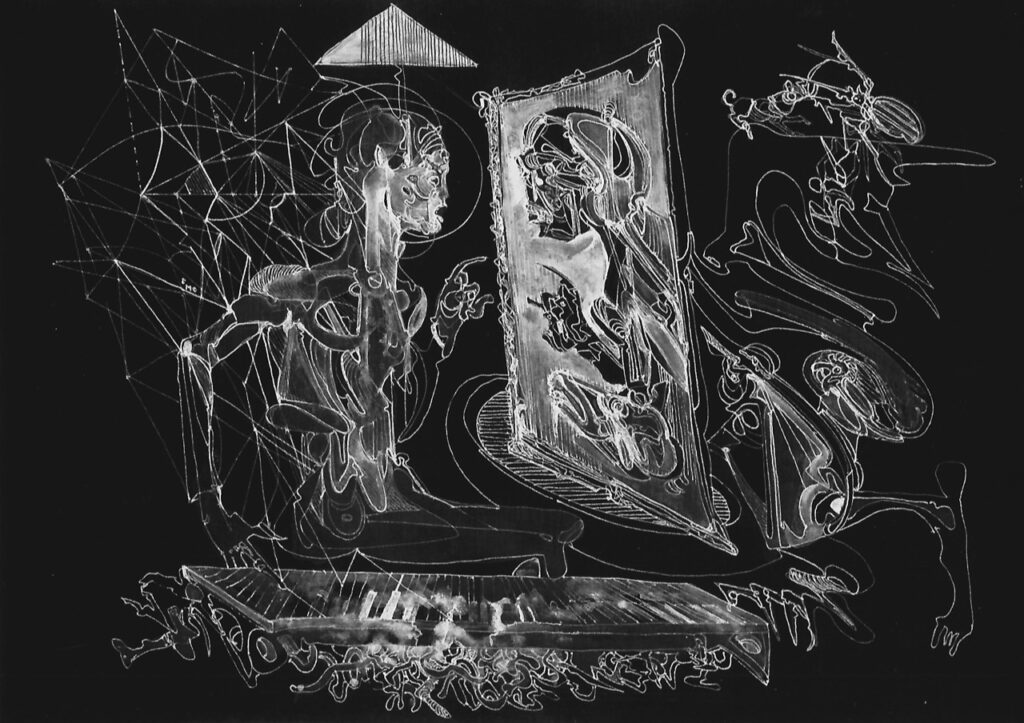When renowned Czech artist Karel Demel discovered the book Les Chants de Maldoror (The Songs of Maldoror) by the Comte de Lautréamont (nom de plume of the Uruguayan-born French writer and poet Isidore Ducasse) he could not but start illustrating it right away. He resonated very strongly not only with its free and surrealistic imagery which is out of the ordinary, but also with its deep philosophical content reflecting on life in general, and on mankind and its potential evilness in particular. Ducasse crafted the Maldoror personage to reflect in him all the negative and bad characteristics that can exist in this world; he made him misanthropic, anti-God, immoral, wicked, powerful in his destructive ability, free spirited in his wrecking adventure and remorseless. He wanted to make a point, a cautionary message, opening the eyes of the reader about the human condition, and trying at the same time to achieve the sublime through his unusual and new-styled writing and its controversial content. Ducasse aimed as well to trigger in return the positive in his reader’s disposition, and as he said “create something new in the sense of a sublime literature that sings of despair only in order to oppress the reader, and make him desire the good as the remedy.”
Ducasse wrote his book in 1868 at the age of 22 and sadly died, unknown, two years later (1870) at the age of 24. His book, discovered almost 50 years later (1917) in a 2nd hand bookstore in Paris by French poet Philippe Soupault, and shared right then with poet Andre Breton, became the inspirational source and the Bible of Surrealists, poets and artists alike.
Full of provoking imagery, the book served as inspiration for illustrations by many great artists including Salvador Dali, Odilon Redon, René Magritte, Jacques Houplain, Hans Bellmer, to name only a few. Each of these artists interpreted differently the text and images of Ducasse, infusing them with their own personal perspective. Karel Demel’s approach to them was different, letting himself err and be lost in the labyrinthine world of the author, creating, thanks to his automatic and fluid drawing approach, imaginary and surreal living tableaux, beautiful in their esthetic, yet arresting by their content.
I met Karel Demel for the first time two years ago at his home in Prague. We immediately hit it off. We spoke French, shared cultural French references, in particular the songs of Georges Brassens and Jacques Brel, and spoke then of Ducasse’s book that Demel seemed to be fascinated with and that he said he had extensively illustrated.
I had not read the book but was vaguely familiar with the author, the Comte de Lautréamont, having translated into French, a few years earlier, a poem related to him by my good friend, the Colombian poet Armando Romero.
Demel showed me his intricate and exquisite drawings and etchings based on the book and we both felt it would be great to share them with the Cincinnati residents, where I live, exposing them at the same time to the seminal book that had served as the cradle of the surrealism movement.
Two years later, the exhibit “MALDOROR: Surrealist Drawings and Prints by Czech Artist Karel Demel,” is taking place at the Kennedy Heights Arts Center in Cincinnati. It consists of 30 B&W drawings and 19 color etchings, Demel’s surrealistic illustrations of the influential book. The etchings, often replicating an image of one of the drawings, adding to it color, showing Demel’s masterful skill and ability as a printmaker.
In fact, Demel is one of the leading artists and printmakers of Czech Republic. Born in Prague in 1942, he graduated from its Conservatory and its Academy of Applied Arts in 1974. His artwork, strongly inspired by music and poetry, displays a brilliant draftsmanship, often combining several printmaking techniques such as drypoint, etching, mezzotint and aquatint. His compositions are technically impressive and often relate to philosophical questioning regarding human existence and the complicated nature of human life and fate. So no wonder he was attracted right away to Ducasse’s book and embarked on illustrating it.
Demel’s illustrative drawings are exquisite and intriguing, combining real and imaginary elements, each addressing one passage of the book, a scene, a person, a story, making a statement about it. They are fluid, consisting of often uninterrupted white line drawings on a black background, enhanced here and there by a white wash giving depth and a somewhat unreal mood to their image. They create a pleasing yet mysterious world that draws in deeper the viewer who tries to decipher and analyze its various elements. This world is Ducasse’s but also Demel’s attempting to escape in it and recreating it as his own.
Demel’s illustrative color etchings are often based on one of his drawings and reflect the technical mastery of the artist. They are small, intricate, intimate enough to become also the viewer’s own world.
Both drawings and etchings are inhabited by the many monstrous humans and animals that Ducasse portrays in his writings. We see the woman prostitute, the man digging his grave, the toad, the dogs barking and tearing each other apart, the man making love to a shark, the mirror reflecting beauty and ugliness, the spherical majestic ocean, the man and woman at the doors of life, Maldoror attacked by the tarantula…
All these images that haunted Demel end up haunting us, we viewers, as well, and thanks to their surreal beauty, exercise a powerful impact on us. Thanks to Demel, they stay with us, and as Ducasse intended, make us “desire the good as the remedy.”
Exhibition at the Kennedy Heights Arts Center, Lindner Gallery
September 1-28, 2023




